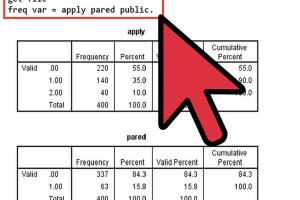Mastering Data Analysis with SPSS: A Comprehensive Guide for Beginners

-
Quick Links:
- Introduction
- What is SPSS?
- Installing SPSS
- Inputting Data into SPSS
- Data Cleaning and Preparation
- Descriptive Statistics
- Inferential Statistics
- Visualizing Data
- Case Studies
- Tips and Tricks for Effective Analysis
- Conclusion
- FAQs
Introduction
SPSS (Statistical Package for the Social Sciences) is one of the most widely used tools for statistical analysis in social science, health research, and business. It allows researchers and analysts to handle data efficiently, conducting various statistical tests and interpreting results effectively. This comprehensive guide will lead you through the entire process of analyzing data using SPSS, from installation to advanced statistical analysis.
What is SPSS?
SPSS is a powerful software suite designed for statistical analysis, developed by IBM. It provides a user-friendly interface and a plethora of statistical tools, making it accessible for beginners while offering advanced features for seasoned analysts. Key functionalities include:
- Data management and manipulation
- Statistical tests (t-tests, ANOVA, regression, etc.)
- Graphical data representation
- Output management and reporting
Installing SPSS
To get started with SPSS, you need to install the software on your computer:
- Visit the IBM SPSS Statistics website.
- Choose the appropriate version for your operating system.
- Follow the installation instructions provided.
- Activate your license using the serial number received upon purchase.
Ensure that your system meets the minimum requirements for optimal performance.
Inputting Data into SPSS
Once SPSS is installed, the next step is to input your data:
- Open SPSS and create a new dataset.
- Enter data manually in Data View or import data from external sources like Excel, CSV, or database files.
- Define variables in Variable View, specifying their names, types, and labels.
Data Cleaning and Preparation
Data cleaning is crucial for accurate analysis. This process involves:
- Identifying and handling missing values.
- Removing duplicates.
- Correcting data entry errors.
- Ensuring consistent data formatting.
SPSS offers various tools to assist in data cleaning, including the Data > Select Cases feature to filter out unwanted data.
Descriptive Statistics
Descriptive statistics summarize your data, providing insights into its central tendency and variability. Common measures include:
- Mean (average)
- Median (middle value)
- Mode (most frequent value)
- Standard deviation (measure of dispersion)
To compute these statistics in SPSS, navigate to Analyze > Descriptive Statistics > Descriptives.
Inferential Statistics
Inferential statistics help make predictions or inferences about a population based on sample data. Common techniques include:
- T-tests: Compare means between two groups.
- ANOVA: Compare means across multiple groups.
- Regression Analysis: Assess relationships between variables.
To conduct these analyses in SPSS, navigate to Analyze > Compare Means or Analyze > Regression.
Visualizing Data
Visual representation of data enhances understanding and communication of findings. SPSS provides various graphical options:
- Bar charts
- Histograms
- Box plots
- Scatter plots
Access these options through Graphs > Chart Builder to create compelling visuals.
Case Studies
To illustrate the application of SPSS in real-world scenarios, consider the following case studies:
Case Study 1: Customer Satisfaction Survey
A retail company conducted a survey to gauge customer satisfaction. Using SPSS, they analyzed responses and identified key areas for improvement.
Case Study 2: Health Research
A public health study used SPSS to analyze the effects of a new medication. Inferential statistics helped determine the medication's efficacy across different demographics.
Tips and Tricks for Effective Analysis
Here are some expert tips to enhance your data analysis using SPSS:
- Always back up your data before making significant changes.
- Utilize SPSS syntax to automate repetitive tasks.
- Regularly update SPSS for the latest features and bug fixes.
- Engage with online SPSS communities and forums for support and resources.
Conclusion
Analyzing data using SPSS can seem daunting at first, but with practice and familiarity, it becomes an invaluable skill. This guide has provided you with the foundational knowledge needed to effectively utilize SPSS for data analysis. Remember to approach your data with a critical eye and a willingness to learn and adapt!
FAQs
1. What is the main function of SPSS?
SPSS is primarily used for statistical analysis, enabling users to conduct various statistical tests and interpret data effectively.
2. Can I use SPSS for qualitative data analysis?
While SPSS is primarily designed for quantitative data, it can handle some qualitative data through coding and categorization.
3. How do I import data into SPSS?
You can import data into SPSS from various formats, including Excel, CSV, and databases, by using the File > Open > Data option.
4. What are the benefits of using SPSS?
SPSS offers a user-friendly interface, extensive statistical tools, and robust data management capabilities, making it ideal for researchers and analysts.
5. Is SPSS suitable for beginners?
Yes, SPSS is designed to be accessible for beginners, with numerous tutorials and resources available to help users learn the software.
6. How can I visualize data in SPSS?
SPSS provides various options for visualizing data through charts and graphs, accessible via the Graphs > Chart Builder menu.
7. What types of statistical tests can I perform with SPSS?
SPSS allows users to perform a wide range of statistical tests, including t-tests, ANOVA, regression analysis, correlation, and more.
8. How can I handle missing data in SPSS?
SPSS provides options for managing missing data, including listwise and pairwise deletion methods, and various imputation techniques.
9. Does SPSS support automation?
Yes, SPSS supports automation through syntax scripts, allowing users to record and execute repetitive tasks efficiently.
10. Where can I find additional SPSS resources?
For additional resources, consider visiting the IBM Support Page and engaging with online SPSS forums and communities.